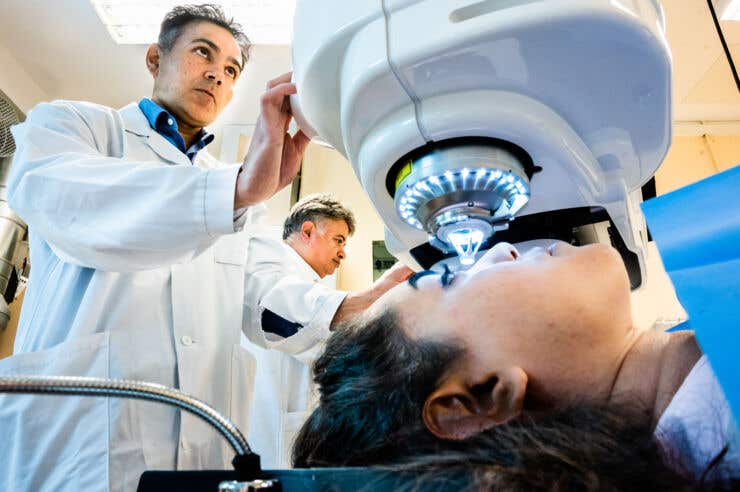Cutting-edge implants restore vision to the blind and visually-impaired
A new bioengineered implant has shown promising results in restoring vision for those suffering from corneal blindness and low vision.

[May 14, 2023: Staff Writer, The Brighter Side of News]
The researchers have developed a new, minimally invasive method. A small incision is made, through which the implant is inserted into the existing cornea. The incision can be made with an advanced laser (as in the photo), but also, when needed, by hand with simple surgical instruments. (CREDIT: Thor Balkhed)
A new bioengineered implant has shown promising results in restoring vision for those suffering from corneal blindness and low vision.
Researchers at Linköping University (LiU) and LinkoCare Life Sciences AB have developed a biomaterial that meets all the criteria for being used as human implants, providing an alternative to the transplantation of donated human corneas, which are scarce in countries where the need for them is greatest. The study was published in Nature Biotechnology.
An estimated 12.7 million people worldwide are blind due to their corneas being damaged or diseased. Their only way of regaining vision is to receive a transplanted cornea from a human donor, but only one in 70 patients receives a cornea transplant, and most of those who need cornea transplants live in low and middle-income countries where access to treatments is limited.
“The results show that it is possible to develop a biomaterial that meets all the criteria for being used as human implants, which can be mass-produced and stored up to two years and thereby reach even more people with vision problems,” says Neil Lagali, a professor at the Department of Biomedical and Clinical Sciences at LiU, and one of the researchers behind the study.
Related News
The cornea consists mainly of the protein collagen. To create an alternative to human cornea, the researchers used collagen molecules derived from pig skin that were highly purified and produced under strict conditions for human use.
The pig skin used is a by-product of the food industry, making it easy to access and economically advantageous. In the process of constructing the implant, the researchers stabilized the loose collagen molecules forming a robust and transparent material that could withstand handling and implantation in the eye.
While donated corneas must be used within two weeks, the bioengineered corneas can be stored for up to two years before use.
Femtosecond laser interface used for cutting and reshaping the cornea. (CREDIT: Thor Balkhed)
“The safety and effectiveness of the bioengineered implants have been the core of our work,” says Mehrdad Rafat, the researcher and entrepreneur behind the design and development of the implants. He is an adjunct associate professor (senior lecturer) at LiU’s Department of Biomedical Engineering and founder and CEO of the company LinkoCare Life Sciences AB, which manufactures the bioengineered corneas used in the study.
“We’ve made significant efforts to ensure that our invention will be widely available and affordable by all and not just by the wealthy. That’s why this technology can be used in all parts of the world,” he adds.
A bioengineered implant could be an alternative to the transplantation of donated human corneas. (CREDIT: Thor Balkhed)
A new, minimally invasive method for treating the disease keratoconus, in which the cornea becomes so thin that it can lead to blindness, has also been developed. Today, a keratoconus patient’s cornea at an advanced stage is surgically removed and replaced by a donated cornea, which is sewn into place using surgical sutures. This kind of surgery is invasive and only done at larger university hospitals.
“A less invasive method could be used in more hospitals, thereby helping more people. With our method, the surgeon doesn’t need to remove the patient’s own tissue. Instead, a small incision is made, through which the implant is inserted into the existing cornea,” says Neil Lagali, who has led the research group that has developed this surgical method.
The implant resembles the human cornea and is made of collagen protein from pig’s skin. (CREDIT: Thor Balkhed)
No stitches are needed with this new surgical method. The incision in the cornea can be made with high precision thanks to an advanced laser, but also, when needed, by hand with simple surgical instruments. The method was first tested on pigs and turned out to be simpler and potentially safer than a conventional cornea transplant.
The surgical method and the implants were used by surgeons in Iran and India, two countries where many people suffer from corneal blindness and low vision, but where there is a shortage of donor corneas for transplantation. The surgeries were successful, and many patients who had previously been unable to see were now able to see again with the help of the new implants.
Neil Lagali, professor at Linköping University, and Mehrdad Rafat, adjunct senior lecturer at Linköping University and founder of the company LinkoCare Life Sciences AB. (CREDIT: Thor Balkhed)
As news of the successful surgeries spread, more and more people with corneal blindness and low vision began to seek out the surgical method and implants. Surgeons from around the world traveled to Iran and India to learn from the experts and to observe the surgeries being performed.
Over time, the surgical method and the implants became more refined and more effective. The implants were made smaller and more flexible, making them easier to insert and reducing the risk of complications. The surgical method became faster and less invasive, allowing for shorter recovery times and less discomfort for the patients.
Clinical data from subjects in Iran receiving BPCDX. Keratometric and corneal thickness maps from the same subject indicate the thin and steep pre-operative cornea that was substantially thickened and flattened after intrastromal implantation of a 440-µm-thick BPCDX. (CREDIT: Nature Biotechnology)
As the technology continued to evolve, the cost of the surgeries and implants began to come down, making them more accessible to people in need. Governments and charitable organizations began to fund programs to provide free or low-cost surgeries to those who could not afford them.
Today, the surgical method and the implants are widely used around the world to treat corneal blindness and low vision. Millions of people have been able to see again thanks to these life-changing technologies, and the researchers and surgeons who developed them are hailed as heroes in the field of ophthalmology.
Note: Materials provided above by The Brighter Side of News. Content may be edited for style and length.
Like these kind of feel good stories? Get the Brighter Side of News' newsletter.
Joseph Shavit
Head Science News Writer | Communicating Innovation & Discovery
Based in Los Angeles, Joseph Shavit is an accomplished science journalist, head science news writer and co-founder at The Brighter Side of News, where he translates cutting-edge discoveries into compelling stories for a broad audience. With a strong background spanning science, business, product management, media leadership, and entrepreneurship, Joseph brings a unique perspective to science communication. His expertise allows him to uncover the intersection of technological advancements and market potential, shedding light on how groundbreaking research evolves into transformative products and industries.



